There are few things more wonderful than sharing your home with a dog. The love, affection, and energy that they share is just priceless. But owning a dog is not just a pleasure; it is also a responsibility.
You are responsible for the health and happiness of the dog and also for ensuring that they are not a nuisance, or worse, for the people around them.
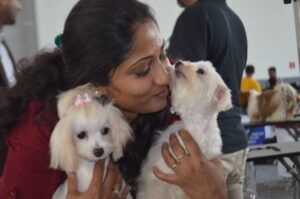 If you were lucky enough to grow up with dogs, you might have an inkling of exactly how much work is involved in training and caring for a dog. But if you are a first time dog owner, the time and commitment you need to put into having a dog can be a surprise.
If you were lucky enough to grow up with dogs, you might have an inkling of exactly how much work is involved in training and caring for a dog. But if you are a first time dog owner, the time and commitment you need to put into having a dog can be a surprise.
First time dog owners can make the task of learning how to care for a dog easier by putting in a little bit of thought when selecting a dog breed.
Assuming that you are not experienced with dogs, you are going to want a dog with a naturally friendly temperament and who is unlikely to develop nasty habits such as barking at strangers or worse.
You are also going to want to look for a dog that is highly trainable, so that you can teach your dog how to behave, without necessarily having to call in the help of an expert. Finally, you are going to want a dog that fits your lifestyle.
If you are keen to take your dog out on the trail with you, a lap dog that struggles to keep up and gets easily hurt is not going to fit the bill.
If you live in a small home and work long hours, a high energy dog that needs lots of exercise and suffers from separation anxiety is going to cause you problems.
Well, that is all well and good, but which of the many dog breeds out there fit the bill?
We have come up with a list of 12 dog breeds that are all good for first time owners.
We have provided a round up of their characteristics, such as how much exercise they need, how time consuming it is to groom them, and how easy they are to train, to help you choose the best breed for your particular circumstances.
We have also come up with a list of five dog breeds that newbie owners should definitely avoid!
These breeds give some insight into the pitfalls that first-time owners can fall into if they don’t choose their dog carefully.
We have also provided a list of the important things to consider when choosing a dog so that you know when to start when making your choice.
Top Best Dog Breeds For First Time Owners
 1. Boxer
1. Boxer
Medium to large
- High energy; need lots of exercise
- Low maintenance grooming
- Moderate to train
- Good for families
Boxers make great pets if you are looking for a high energy dog that will be happy to accompany you and your family on all your adventures. But bear in mind that just because you are busy doesn’t mean that they don’t need exercise.
These dogs can become quite frustrated if they miss their daily walk. Fortunately, they aren’t too big that older kids can’t take them out on their own.
Boxers need to undergo strict obedience training when they are young to teach them appropriate behavior, and they aren’t the easiest dogs to train, so you might benefit from some professional training help.
But once they are all trained up, they will quickly form a bond with the family. Natural guardians, they will quickly become the protectors of the family, especially children.
Boxers are also dogs that are easy to take care of, as their grooming needs are pretty basic. They also don’t shed too much around the house.
Our Experience: We’ve never owned a Boxer, but one of our best friends had two Boxers. They were wonderful dogs although a little goofy. I remember his male jumped off a balcony he was so excited to say hello.
 2. Cavalier King Charles Spaniel
2. Cavalier King Charles Spaniel
Small to medium
- Energetic, average exercise needs
- High maintenance grooming
- Relatively easy to train
- Good if you want a dog for every moment
If you are looking for a dog that will both love exploring local trails with you and curling up on your lap at the end of a long day, then a Cavalier King Charles Spaniel is a great choice.
These little dogs are surprisingly energetic and resilient, but they are also highly affectionate and loves cuddles. And they are small enough that you won’t mind having them on your lap.
These dogs are pretty intelligent and learn quickly, so you should be able to train them yourself, even if you are a newbie to training dogs.
They generally learn new commands after 25 to 40 repetitions. The big downside with these dogs is that they do need regular grooming to maintain their long coat, but most dog owners find this to be a fun bonding experience.
Cavalier King Charles Spaniels love to be near you and can suffer with a bit of separation anxiety if you leave them alone a lot, but this is not as bad as many other dog breeds. But with their adaptable temperament and friendly nature, you should be able to take them almost anywhere with you.
Our Experience: Our co-worker got a Cavalier King Charles Spaniel after she did a lot of research for dogs good with children. Benny was an awesome dog! One of my fondest memories was watching him try to catch embers coming out of the fire pit…so maybe not the sharpest tool in the shed. I do recall Benny being prone to ear infections with those long floppy ears.
 3. Greyhounds
3. Greyhounds
Medium to large
- Moderate exercise needs
- Low maintenance grooming
- Easy to train
- Good for small homes
If you are looking for a big dog, but you have a small home, greyhounds can make a great choice.
Despite their reputation as racers, greyhounds are notoriously lazy and will be happy spending most of the day flopping around the house doing nothing. But when you do take them out, they enjoy a good run to let off some steam.
These are pretty intelligent dogs, so they are easy to train, and they are also very low maintenance to groom.
Their thin coat is low maintenance, but that also means that they don’t do that well in the cold. Make sure you make them a nice snuggly bed to keep warm in the winter months.
Consider adopting a retired racing greyhound who have seen their day in the spotlight and are now looking for a loving home to relax in. Plus, they’ll be mostly trained up for you.
Our Experience: One of our hockey buddies had two rescue greyhounds and they lived up to their reputation as couch potatoes. This is one breed we have not had a ton of experience with, but my friend assures me they are a great starter dog.
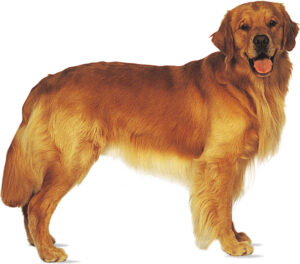 4. Golden Retriever
4. Golden Retriever
Large
- Significant exercise needs
- High maintenance grooming
- Easy to train
- Good for families and active people
Golden Retrievers make popular pets because they are big, fun, energetic dogs, but they are so easy to train that you should have no trouble keeping the 50 to 70 pounds of them under control.
They need less than five repetitions to learn a new command, which means even newbie dog owners should be able to take on their training.
But Golden Retrievers are quite a bit of work. As well as the significant amount of exercise that they need daily, their long hair means that they need quite a lot of grooming.
They are also shedders and will leave hair around your home.
QUICK NOTE: Goldendoodles were bred specifically to deal with the excessive shedding of goldens.
Golden Retrievers make great companions when it comes to adventures. They can spend all day on the trail with you and will still be begging for more.
Our Experience: We’ve done a lot of work with Golden Retrievers as service dog trainers. We love this breed and they make great family dogs. It’s true they are high energy and require a decent amount of exercise. We currently have an English Cream Golden Retriever named Raven.
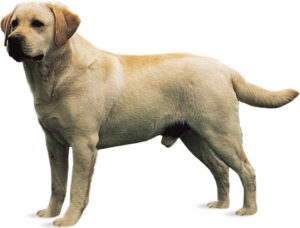 5. Labrador Retriever
5. Labrador Retriever
Large
- Significant exercise needs (see our article on how much exercise Labradors need)
- Moderate grooming
- Easy to train
- Good for families and active people
Labs have it all really: they are smart, affectionate and energetic, all wrapped up in an adorable package that somehow manages not to be overwhelming.
Because they are such a smart breed, it can take fewer than five repetitions to teach them something new. This means that you always feel like you are in control, despite the size of the dog.
This, along with their friendly and affectionate nature, is one of the reasons that they are often chosen as service dogs.
Labs make great companions for active people or families, as they love spending hours out and about and also adore swimming.
While they are great with children and always protective and caring, they should not be left alone with small children. Weighing up to 80 pounds, accidents can happen.
Despite the short length of their coats, Labs do need quite a bit of grooming as they shed a lot of hair. Expect to be cleaning your carpets and furniture on a regular basis.
If you’re not too keen on how much a Lab sheds then you might consider a Labradoodle.
Our Experience: #5 on our list, #1 in our hearts! We love our Labrador Retriever and we’ve trained dozens for the service dog schools. One thing I’d like to point out about most Labs we’ve raised is they love to eat! So, be sure and watch your Labs weight. If your dog is overweight it could lead to health problems.
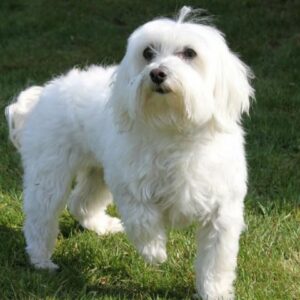 6. Maltese
6. Maltese
Small
- Low exercise needs
- Moderate grooming
- Easy to train
- Good for small homes
There is a reason that Maltese appear in all the dog food commercials. Not only do their little stomachs make that expensive dog food affordable, but their gorgeous fluffy faces combined with their intelligence makes them the ideal actors.
They are incredibly easy to train and even first time owners should have few problems.
Maltese were actually bred to keep humans company, rather than as working dogs, so they have a naturally friendly and affectionate nature and will form bonds with members of the household quickly (including the cat). They love nothing more than to curl up on your lap at night.
They are highly energetic, which makes them fun, but their little legs means that they don’t need long walks or unending games of fetch.
Because of their very small size, they can be quite fragile, which means they can suffer a bit at the treatment of heavy handed children. They are better suited with slightly older kids.
Our Experience: Another lifetime ago I used to work for a Cisco Training Partner (yep, the IT world). One of my co-workers brought in her adorable Maltese, Sam. He was pretty much as mentioned above: a great companion, friendly, and affectionate.
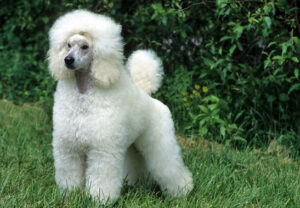 7. Poodles
7. Poodles
Various sizes
- Moderate exercise needs
- High maintenance grooming
- Easy to train
- Good for anyone
Poodles make pretty good dogs for pretty much anyone. They are so intelligent that they are easy to train and can adapt quickly to pretty much any situation or household.
You can also pretty much choose what size your want, with normal Poodles being medium-sized dogs, but with miniature and toy Poodles also available without losing any of their signature intelligence.
The amount of exercise that poodles need depends on their size, with normal size Poodles needing a surprising amount of exercise. But the main reason why some people shy away from Poodles is that they need pretty regular grooming.
They are actually called a hypoallergenic dog because they don’t shed. But that is because their dead hair stays in their thick coat, which then needs to be brushed out regularly.
Poodles also require a lot of attention. As well as exercise, these intelligent pooches need mental stimulation. If they don’t get what the need, they will turn those smart brains of theirs into ways of making trouble.
Our Experience: You might say my previous job was dog friendly, very dog friendly. We saw our friend Sam the Maltese every day we also saw Quincy the Poodle every day. We even house sat Quincy several times. Cute and adorable, smart and energetic would describe Quincy the Poodle.
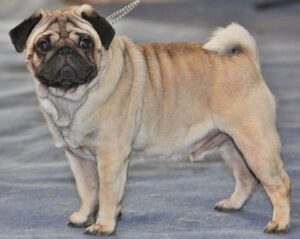 8. Pugs
8. Pugs
Small to medium
- Energetic but with limited exercise needs
- Low maintenance grooming
- Moderate to difficult to train
- Good for quieter households
Pugs make a good dog choice if you are looking for a low maintenance friend. While they are energetic and fun to play with, they get worn out quickly, so you won’t be caught playing fetch for hours on end.
They also have short hair that is easy to groom yourself. They will be happy pretty much just hanging out around the house and yard.
Pugs aren’t the most intelligent dogs, so it can be time consuming to train them. If you aren’t sure what you are doing, it can be a good idea to work with a professional to help them master the basics, such as house training.
They are also heavier than they look, so be aware if you don’t have the strength to lift heavy things.
The main challenge with pugs is that, while they might be low maintenance at the beginning of their lives, they can become very high maintenance near the end of their lives as they tend to suffer with health problems, particularly when it comes to breathing because of their adorable flat face.
This can be expensive and also emotionally grueling when you have spent 10 years building a bond.
Our Experience: Our friend had a Pug named Gui. Truth to them being heavier then you’d expect.
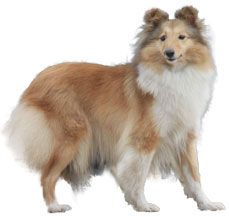 9. Shetland Sheepdog
9. Shetland Sheepdog
Large
- Energetic, lots of exercise
- High-maintenance grooming
- Easy to train
- Good for larger properties
If you do have a larger property and you are looking for a dog that will enjoy it, considered a Shetland Sheepdog. Highly intelligent, these dogs are easy to train.
They are also loyal and affectionate and will quickly feel like a member of the family that you can’t imagine not having around. But be aware, these dogs do suffer from separation anxiety if they are left alone for too long.
Bred as working dogs, Shetland Sheepdogs do need a lot of exercise, and they thrive best when they have a pretty big space that they can call their own. But if you have a property, or even just a large yard, they will be happy there.
The main downside with these dogs is that they are pretty high-maintenance when it comes to grooming. Their long hair combined with their outdoors lifestyle mean that bushing and baths need to happen pretty frequently. Unlike bathing a small dog, considering the size of the breed, this may well feel like work!
Our Experience: One of our best friends owned a Shetland Sheepdog and lucky for their dog, Toffee she had room to roam on their mult-acre property. One thing I remember is how much she loved to chase cars. Probably not a good habit for any dog.
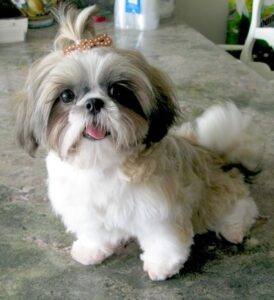 10. Shih Tzus
10. Shih Tzus
Small
- Energetic but with limited exercise needs
- High maintenance grooming
- Difficult to train
- Good family dog for small homes
There is no denying that Shih Tzus are adorable and that you, as well as any small children in the home, will fall in love with them immediately.
They make great play companions for kids as they have the energy to rough and tumble, but unlike large dogs, aren’t likely to accidentally hurt children when they forget their own weight.
Also, despite being highly energetic, their little legs mean that they don’t need a huge amount of exercise, and you can squeeze in quick walks while managing a busy household.
A word of warning: Shih Tzus aren’t known for their intelligence, which means that they can be hard to train. It is said that they need 80 to 100 repetitions to learn something new.
If you don’t have experience training dogs, it is probably a good idea to invest in a professional dog trainer to show them the basics. Once they are toilet trained and know not to eat your shoes, you can take on the challenge of teaching them any fun tricks.
These dogs have a pretty small appetite, so can be light on the wallet when it comes to food. However, their coats do need regular grooming, so that is a time commitment from you and you will probably want to take them to a professional groomer periodically.
Our Experience: My Grandma had a Shih Tzu named Chibi – means small in Japanese. Chibi was a great companion for my Grandma and got her up out and about. I never trained one of these little pups so I can’t attest to how long it takes to train a Shih Tzu.
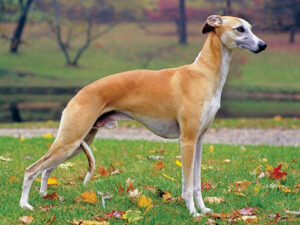 11. Whippets
11. Whippets
Medium
- Moderate exercise needs
- Low maintenance grooming
- Easy to train
Good if you want a bigger dog in a small home
Bred for racing and resembling fury Greyhounds but a bit smaller, Whippets are actually great dogs if you like getting out on the trail, but live in a fairly small space, like an apartment.
Whippets love to run and will enjoy going out on the trail with you, but they are also pretty lazy couch potatoes, and won’t mind spending the vast majority of the day sitting around the house doing nothing. They may remind you of your teenage son.
Their coats are very thin and easy to groom, but that means they don’t deal well with the cold. They are better off in warmer environments and benefit from a doggy coat in the colder months.
These dogs are pretty intelligent, so they are easy to train, and it is a challenge that you can take on yourself, even if you are new to it. Also, they are easier to house train than some smaller breeds as they have larger bladders.
Our Experience: My aunt owned a Whippet. Her Whippet was intelligent, but shy. Also, I recall him being her constant companion. I do remember her Whippet always wearing some kind of jacket or clothing to keep him warm.
 12. Yorkshire Terrier
12. Yorkshire Terrier
Small
- Limited exercise needs
- High maintenance grooming
- Difficult to train
- Good lap dog
If you are looking for a small dog that will be happy to pass the day at home with you and loves cuddles, then a Yorkshire Terrier makes a great choice.
They have pretty limited exercise needs and will be happy with a short daily walk that is healthy for both you and them. They are affectionate and are the perfect partner for curling up on the couch on chilly evenings.
However, be aware that Yorkshire Terriers are high maintenance when it comes to grooming. Their hair grows continuously and needs to be brushed and cut regularly, by both you and a professional. However, many dog owners enjoy this time together with their dog, and it can be a great bonding experience.
Also, take care to invest in their training from the beginning, otherwise they can become barkers. This can be particularly problematic if you are living in an apartment with neighbors close by.
Our Experience: My in-laws always have a Yorkie named Yuki. She’s pretty much everything said above with one caveat…Yuki loves to eat and is over weight. I’m not sure if this is common for the breed, but if you do have an eater make sure to limit the amount of food and get your Yorkie ample exercise.
5 Dog Breeds Newbie Owners Best Avoid
Sometimes when you get your first dog, it can be because a friend’s dog has had a litter and they are trying to convince you to take one. That is great, but there are a few breeds that you should be wary of.
1. Beagles
Beagles may look like little intelligent dogs, but they are notoriously difficult to train. This is not because they lack intelligence, but because they are strong willed, not to mention make a lot of noise while chasing down game.
Without a very firm hand, beagles are likely to bark at every passing stranger and nip at the heels of children. Despite their small size, they aren’t for the uninitiated.
2. Border Collies
Border Collies were bred for farm work, so they have a mixture of intelligence and energy. That energy can be very difficult to use, and when they don’t use all their energy, they use their intelligence to find the strangest ways to cause havoc. Unless you have a nice big property for them to dominate, best skip this breed.
Growing up we had a Border Collie mix named Maffy. We loved this dog, but he had energy to burn. He played, played, played, then played some more. Highly intelligent. He used to escape our backyard where we’d find him at our elementary school playground playing with the kids.
3. Dalmatians
First time dog owners probably should not have one Dalmatian, let alone 101. While these are intelligent dogs that are highly trainable, they were specifically bred to run barking in front of fire engines, and that is what they will want to do at home with you!
They are high energy and noisy. Combine that with their large size and they can be very difficult to manage if you don’t know what you are doing.
4. Shiba Inus
While Shiba Inus are adorable dogs that look a little bit like small wolves, first time owners will struggle with them.
They are often likened to cats in their independence, and so despite being intelligent, they are notoriously difficult to train. That, combined with their relatively large size, can be a recipe for disaster if you don’t know what you are doing.
5. Siberian Huskies
Another gorgeous breed that looks a bit like a wolf is the Siberian Husky. Unless you spend all day out on the trail yourself, you are unable to give this dog enough exercise to keep them out of mischief.
Also, Huskies aren’t just barkers, but howlers, which is likely to keep the whole neighborhood up at night unless you are very experienced at working with this type of dog.
A Note About Mixed-Breeds
Also, you will notice that all the dogs on our best list are pure-bred. This is not because there is anything wrong with mixed-breed dogs.
It is just that the behavior, temperament, and intelligence of pure-bred dogs is easier to predict, while mixed-breed dogs can be a bit of a gamble.
If you are thinking of getting a mixed-breed, it can be a good idea to adopt a slightly older dog that has already given an indication of what they will be like.
If you are looking at a puppy, make sure to meet both parents (not just the mother). The puppy is likely to be an unpredictable mix of the two.
Things To Consider When Choosing Your First Dog
Be Realistic
First, before even thinking about what type of dog to get, be realistic with yourself about what is involved in owning a dog, regardless of the breed. Owning a dog is an investment of your time, emotions, and money.
All dogs need extensive training when they are young and love and affection throughout their lives in order to thrive. While some dogs need more exercise than others, they all need be taken out occasionally, and they all need your attention.
Dogs starved of attention and love can quickly become depressed and act out in ways that are difficult to predict and manage.
You should only get a dog if you are committed to making them a part of your life and a member of your family.
In addition to that, dogs need feeding, grooming, regular trips to the vet, and that is just for vaccinations and check ups.
If your dog gets sick, that can be another significant layer of expense. These kinds of costs are nothing compared to the love and companionship that you get from your dog in return, but they are something that you should be prepared for.
Lifestyle
In order for both you and your dog to be happy together, it is important that you choose a dog that suits your lifestyle. Don’t get a dog that suffers with separation anxiety if everyone is out of the house at work for 12 hours a day.
Skip the large breeds if you live in a small apartment. Don’t get a dog that needs hours of exercise every day if you struggle to stay on your feet for a few hours.
Fortunately, there are dogs out there for every person. You can find a dog breed that is a great swimmer and will love accompanying you on all your adventures on land and sea.
You can also find small dogs that are happy to spend all day at home, keeping you company and snuggling up with you on the couch in the evening.
The key is to be realistic about how much time you have to spend with your potential dog and the types of activities that you really want to do together – are you happy to spend hours brushing out their hair? Once you know that, you can make an informed decision about the best dog breed for you.
Trainability
For you and your dog to share your home together, they are going to need training.
They will need to be trained where and when to go to the bathroom, where and when to eat, where they can sleep and where is off limits, and when it is OK to bark and when not to.
They need to learn not to eat your favorite shoes, not to steal food off the kitchen counter, not to make a run for it the minute the front door opens. Basically, training a dog is a lot of hard work.
Some dogs are easier to train than others.
Intelligent dogs, such as Poodles, Golden Retrievers, and Labradors, are the easiest to train as they only need to see a command repeated up to about 5 times in order to understand what is required of them.
Less intelligent breeds may need a command repeated up to 100 times.
But intelligence is not the only factor. Some dogs are super intelligent but have an independent streak that makes it difficult for all but the most experienced trainers to bring them under control.
These dogs are a bit like cats. They understand what you want, but they just don’t care.
First time owners, who presumably don’t have much experience training dogs, should look for more trainable breeds; otherwise, you may quickly find yourself banging your head against a wall as you dog wakes the whole neighborhood with its barks, while happily gnawing on your favorite shoes.
Temperament
First time owners are also better off with dogs with a naturally friendly temperament, rather than going for fighters.
While Rottweilers might get a bit of a bad reputation thanks to their starring roles in many movies, they are highly territorial dogs and extremely jealous.
This can cause them to attack other dogs, and even people, under certain circumstances. They have been bred as protectors and this is their natural instinct.
While they can be trained to control themselves, this is best left to professional trainers who know how to control both the dog and themselves in difficult situations.
Dogs that naturally form bonds with the family, are friendly with strangers and other animals, and unlikely to resort to nipping even in the most stressful circumstances make the best pets for first time dog owner.
This means that they are much less likely to act badly even if they are poorly trained or in a particularly stressful situation.
The Verdict
Everyone should be able to enjoy the pleasure of having a dog in their lives.
Not growing up with dogs or never having had a canine companion before should not be a barrier to the love and fulfillment that comes along with having a dog.
But owning a dog is not all fun and games, it is also hard work!
You are responsible for the well-being and happiness of your dog and for ensuring that they are neither a nuisance or a danger to the people they come into contact with.
This requires a big commitment in terms of training and ongoing care.
Dogs are also a financial commitment, as they thrive off quality foods and require periodic trips to the vet and groomer.
Puppies aren’t just for Christmas, and new dog owner should seriously consider whether they are ready to take on that responsibility before introducing a dog into their lives.
That said, first-time dog owners can make their lives a little easier by choosing the right breed that will be easy for them to care for with little experience, rather than jumping in the deep end with one of the more challenging aggressive or independent breeds.
The best breeds for new owners are intelligent, and therefore, relatively easy-to-train dogs.
They should have naturally friendly temperaments, which means that they are likely to get on with you, strangers, children, and other animals without much work from you.
And they are highly unlikely to develop bad habits such as aggressive barking or biting.
Newbie dog owners should also make sure that they choose the right dog to fit into their lifestyle.
If you want a dog that is happy to potter around the house with you and go out on the occasional walk, then small lap dogs are ideal.
If you are a bit of an adventurer and like to hit the trail, then an energetic dog that will be able to keep up is what you are looking for.
Check out our list of 12 great dogs for first time dog owners to find the ideal dog breed for your first canine companion.
Is there a dog breed that you think is best for new dog owners? #KhabarLive #hydnews







